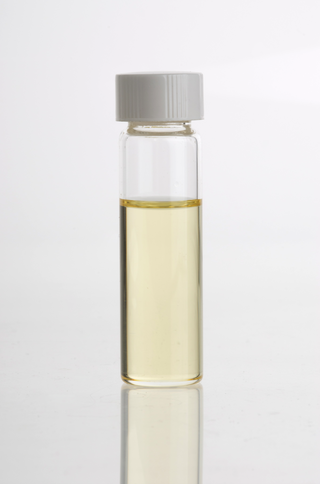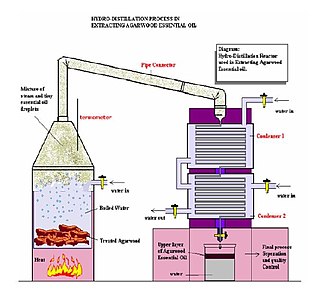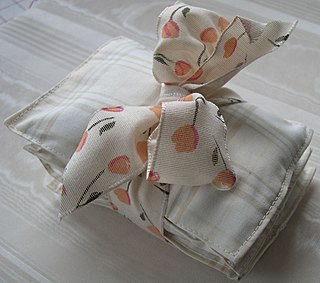
Lavandula is a genus of 47 known species of perennial flowering plants in the mints family, Lamiaceae. It is native to the Old World, primarily found across the drier, warmer regions of mainland Eurasia, with an affinity for maritime breezes.
Perfume is a mixture of fragrant essential oils or aroma compounds (fragrances), fixatives and solvents, usually in liquid form, used to give the human body, animals, food, objects, and living-spaces an agreeable scent. Perfumes can be defined as substances that emit and diffuse a pleasant and fragrant odor. They consist of manmade mixtures of aromatic chemicals and essential oils. The 1939 Nobel Laureate for Chemistry, Leopold Ružička stated in 1945 that "right from the earliest days of scientific chemistry up to the present time, perfumes have substantially contributed to the development of organic chemistry as regards methods, systematic classification, and theory."

An essential oil is a concentrated hydrophobic liquid containing volatile chemical compounds from plants. Essential oils are also known as volatile oils, ethereal oils, aetheroleum, or simply as the oil of the plant from which they were extracted, such as oil of clove. An essential oil is essential in the sense that it contains the essence of the plant's fragrance—the characteristic fragrance of the plant from which it is derived. The term "essential" used here does not mean indispensable or usable by the human body, as with the terms essential amino acid or essential fatty acid, which are so called because they are nutritionally required by a living organism.

Lavender oil is an essential oil obtained by distillation from the flower spikes of certain species of lavender. There are over 400 types of lavender worldwide with different scents and qualities. Two forms of lavender oil are distinguished, lavender flower oil, a colorless oil, insoluble in water, having a density of 0.885 g/mL; and lavender spike oil, a distillate from the herb Lavandula latifolia, having a density of 0.905 g/mL. Like all essential oils, it is not a pure compound; it is a complex mixture of phytochemicals, including linalool and linalyl acetate.

Cananga odorata, known as ylang-ylang or cananga tree, is a tropical tree that is native to the Philippines, Malaysia, Indonesia, New Guinea, the Solomon Islands, and Queensland, Australia. It is also native to parts of Thailand and Vietnam. It is valued for the essential oils extracted from its flowers, which has a strong floral fragrance. Ylang-ylang is one of the most extensively used natural materials in the perfume industry, earning it the name "Queen of Perfumes".

Used in perfumery and aromatherapy, absolutes are similar to essential oils. They are concentrated, highly aromatic, oily mixtures extracted from plants. Whereas essential oils are produced by distillation, boiling, or pressing, absolutes are produced through solvent extraction, or more traditionally, through enfleurage.
Odakkali, located at 10.09 North and 76.54 Eastis a village in the Ernakulam district of Kerala State, in southern India. Odakkali is 26.8 km away from Aluva in Aluva Munnar Road.
Aromachology is the study of the influence of odors on human behavior and to examine the relationship between feelings and emotions. Those who practice aromachology are aromachologists. Aromachologists analyze emotions such as relaxation, exhilaration, sensuality, happiness and well-being brought about by odors stimulating the olfactory pathways in the brain and, in particular, the limbic system. Different wearers are thought to have unique physiological and psychological responses to scents, especially those not manufactured synthetically but based on real scents. The word "aromachology" is derived from "aroma" and "physio-psychology", the latter being the study of aroma. This term was coined in 1989 by what is now the Sense of Smell Institute (SSI), a division of The Fragrance Foundation. The SSI defines aromachology as "a concept based on systematic, scientific data collected under controlled conditions". The term is defined as the scientifically observable influence of smell on emotions and moods. Consumers use aromachology to alleviate time pressures, for relaxation or stimulation and as a component of other activities that generate a feeling of well-being.

Oil of clove, also known as clove oil or eugenol, is an essential oil extracted from the clove plant, Syzygium aromaticum. Clove oil is commonly used in aromatherapy and for flavoring food, tea, and toothpaste. In alternative medicine, it may be used as a topical medication to relieve toothache. There is insufficient medical evidence to support its use as an analgesic for treating pain.

Fragrance extraction refers to the separation process of aromatic compounds from raw materials, using methods such as distillation, solvent extraction, expression, sieving, or enfleurage. The results of the extracts are either essential oils, absolutes, concretes, or butters, depending on the amount of waxes in the extracted product.

Herbal distillates, also known as floral waters, hydrosols, hydrolates, herbal waters, and essential waters, are aqueous products of hydrodistillation. They are colloidal suspensions of essential oils as well as water-soluble components obtained by steam distillation or hydrodistillation from plants and herbs. These herbal distillates have uses as flavorings and cosmetics. Common herbal distillates for skincare include rose water, orange flower water, and witch hazel. Rosemary, oregano, and thyme are hydrosols that may be used in food manufacturing.

The word perfume is used today to describe scented mixtures and is derived from the Latin word per fumus. The word perfumery refers to the art of making perfumes. Perfume was refined by the Romans, the Persians and the Arabs. Although perfume and perfumery also existed in East Asia, much of its fragrances were incense based. The basic ingredients and methods of making perfumes are described by Pliny the Elder in his Naturalis Historia.

Eau de toilette is a lightly scented perfume. It is also referred to as aromatic waters and has a high alcohol content. It is usually applied directly to the skin after bathing or shaving. It is traditionally composed of alcohol and various volatile oils. Traditionally these products were named after a principal ingredient; some being geranium water, lavender water, lilac water, violet water, spirit of myrcia and 'eau de Bretfeld'. Because of this, eau de toilette was sometimes referred to as "toilet water".

Attar, also known as ittar, is an essential oil derived from botanical or other natural sources. Most commonly these oils are extracted via hydrodistillation or steam distillation. The Persian physician Ibn Sina was the first to derive the attar of flowers from distillation. Attar can also be expressed by chemical means but generally natural perfumes which qualify as attars are distilled with water. The oils are generally distilled into a wood base such as sandalwood and then aged. The aging period can last from one to ten years depending on the botanicals used and the results desired. Technically attars are distillates of flowers, herbs, spices and other natural materials such as baked soil over sandalwood oil/liquid paraffins using hydrodistillation technique involving a still and receiving vessel. These techniques are still in use at Kannauj in India.
Richard Grossinger is an American writer and founder of North Atlantic Books in Berkeley, California.

In general use, herbs are a widely distributed and widespread group of plants, excluding vegetables and other plants consumed for macronutrients, with savory or aromatic properties that are used for flavoring and garnishing food, for medicinal purposes, or for fragrances. Culinary use typically distinguishes herbs from spices. Herbs generally refers to the leafy green or flowering parts of a plant, while spices are usually dried and produced from other parts of the plant, including seeds, bark, roots and fruits.

Aromatherapy is a practice based on the use of aromatic materials, including essential oils and other aroma compounds, with claims for improving psychological well-being. It is used as a complementary therapy or as a form of alternative medicine, and typically is used via inhalation and not by ingestion.

Although its most usual definition is that listed under "packet", a sachet can also mean a small scented cloth bag filled with herbs, potpourri, or aromatic ingredients; or a small porous bag or packet containing a material intended to interact with its atmosphere; for example, desiccants are usually packed in sachets which are then placed in larger packages.

Richard Strozzi-Heckler is an American author, coach, and consultant on "embodied leadership and mastery."














